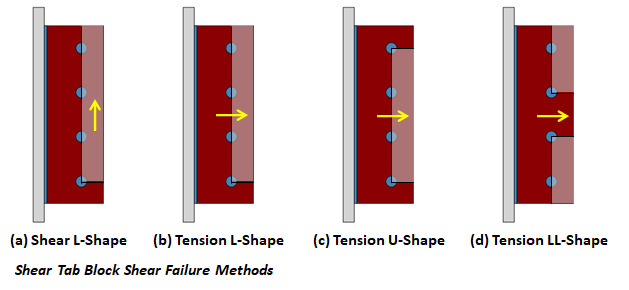Shear Tab connections (also know as Single-Plate connections) are used to connect steel beams to column or girders. VAConnect is capable of designing these connections to support coped beams and to resist both shear and axial loads.
Shear Tab connections are checked per the AISC Steel Construction Manual Part 10 (16th Edition) and AISC 360-22 design specifications. If the dimensional limitations outlined in AISC Manual Part 10 are met (page 10-49), VAConnect automatically designs the connection using the procedure for the conventional configuration. Otherwise, the procedure for the extended configuration is used for design. For both connection configurations, the Instantaneous Center of Rotation method is used to determine the eccentric bolt group capacity (shear, bearing, and tearout) at the shear tab and web of the beam. The Instantaneous Center of Rotation method is also used to determine the capacity of the eccentrically loaded welds groups and base metal. Both the connection configuration and the “C” coefficients for eccentrically loaded bolt groups and eccentrically loaded weld groups are included in the detailed reports.
VAConnect allows shear tab connections to be designed for combined eccentric shear force (force in-plane and parallel to the bolt line) and axial force (force in-plane and perpendicular to the bolt line) according to the AISC Steel Construction Manual Part 12 (16th Edition). Example II.A-19B of the AISC Design Examples Version 16.0 provides a detailed example of an extended shear tab connection subject to axial and shear loading. While previous version of VAConnect relied on engineering judgment to account for the axial force, VAConnect has been revised to closely follow the Part 12 of the AISC Steel Construction Manual (16th Edition) and the aforementioned AISC design example. Specifically, the interaction of the shear, axial, and flexural loads are considered for both the yielding/buckling limit state and for the rupture limit state. Also, the interaction for biaxial block shear is accounted for according to the example. The program’s detailed reports clearly document how the various limit states have been checked.
Note: When the connection has a conventional configuration, the eccentricity is not reduced for load combinations where shear and axial force is present as discussed in the Design Considerations for Single-Plate Connections Subject to Shear and Axial Force in Part 12 of the AISC Steel Construction Manual (16th Edition). See also Example II.A-17B of the AISC Design Examples Version 16.0.
Beams coped at one or both flanges are checked per the AISC Steel Construction Manual Part 9 (16th Edition) and AISC 360-22 design specifications. The 16th Edition of the AISC Steel Construction Manual does not explicitly address how to design coped beams for combined shear and axial loading. Therefore, VAConnect uses the same methodology as the shear tab in Part 12 of the AISC Steel Construction Manual (16th Edition) and in Example II.A-19B of the AISC Design Examples Version 16.0 to account for the interaction of the shear, axial, and flexural loads for both the yielding/buckling and the rupture cases of the coped beam. Furthermore, the interaction for biaxial block shear on the coped beam is accounted for according to the aforementioned example.
VAConnect checks the following limit states for Shear Tabs (refer to the program’s detailed reports for specific code references):
The figure below shows the possible block shear failure methods that VAConnect checks for the shear tab. In addition to checking each case (a through d) independently, the interaction for block shear failure from combined shear and tension is considered. While combined block shear only needs to be checked for case a and case b in the figure below, VAConnect conservatively uses the lowest capacity from case b through case d for tension to combine with case a for shear. VAConnect checks the appropriate block shear failure methods and block shear interaction as needed for the web according to the beam's coped condition.
